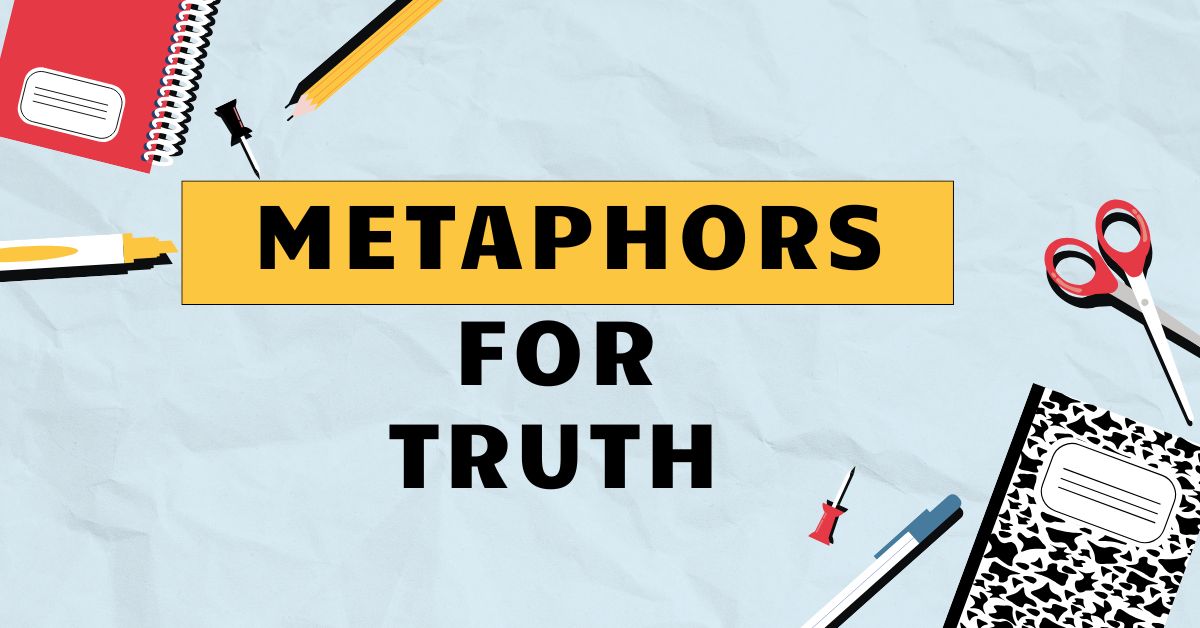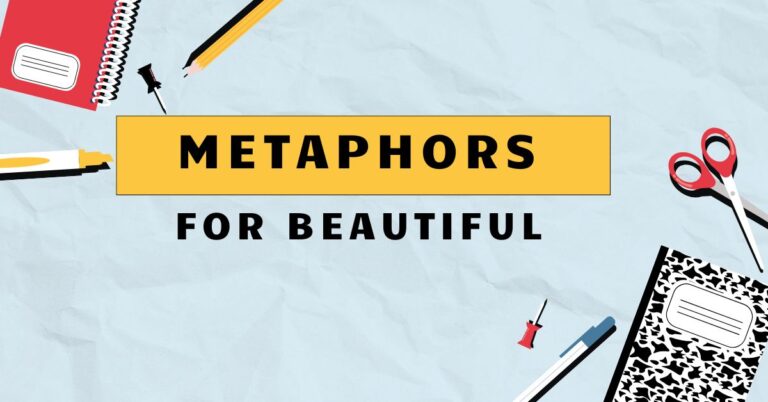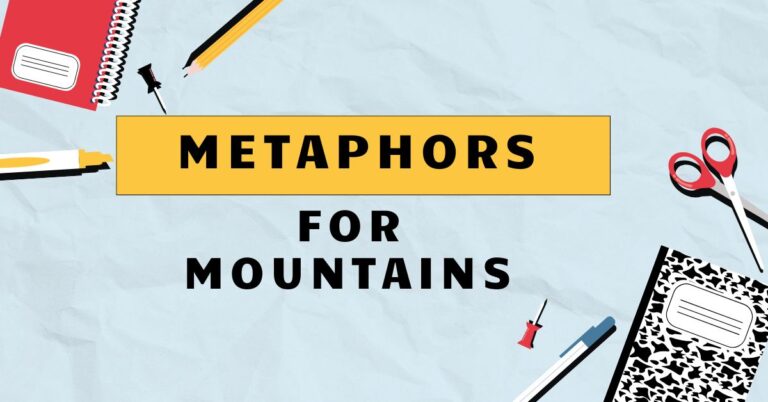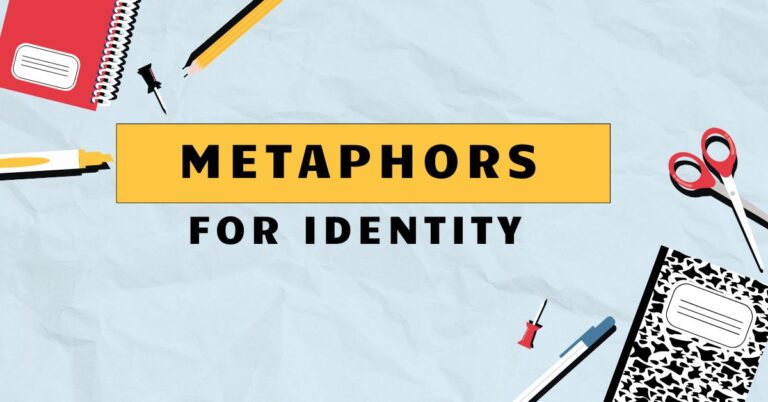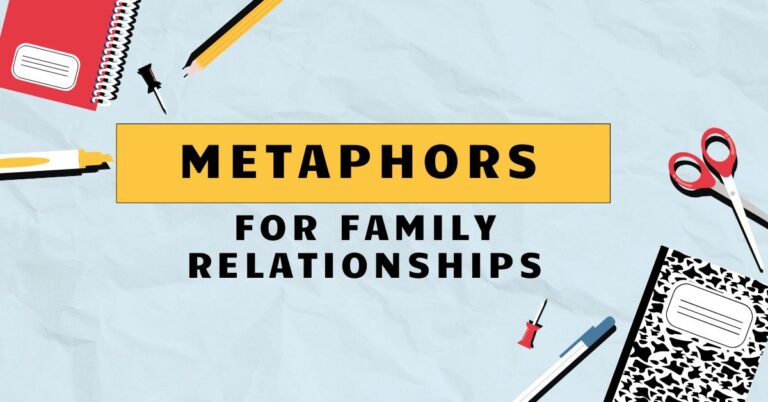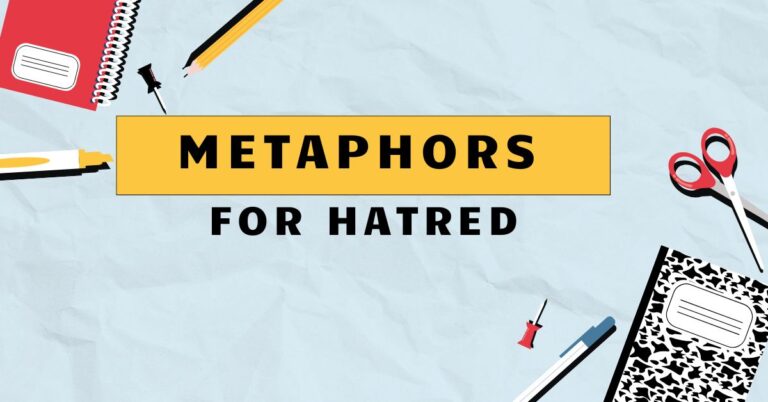46 Metaphors for Truth: Unveiling Figurative Language
Understanding metaphors for truth is crucial for grasping the nuances of English language and literature. Metaphors allow us to express abstract concepts like truth in more relatable and vivid ways, making communication more engaging and impactful.
This article delves into the various types of metaphors used to represent truth, their structural elements, and how to use them effectively. This guide is perfect for English language learners, writers, and anyone interested in enriching their understanding and use of figurative language.
Table of Contents
- Introduction
- Definition of Metaphors for Truth
- Structural Breakdown of Metaphors
- Types of Metaphors for Truth
- Examples of Metaphors for Truth
- Usage Rules for Metaphors
- Common Mistakes with Metaphors
- Practice Exercises
- Advanced Topics in Metaphorical Language
- Frequently Asked Questions
- Conclusion
Definition of Metaphors for Truth
Ametaphoris a figure of speech that directly compares two unrelated things, suggesting a resemblance or shared quality between them. It asserts that one thingisanother thing, not literally, but figuratively, to highlight certain characteristics or create a more vivid image.
Metaphors for truth, specifically, use this comparison to illuminate the often abstract and complex concept of truth, making it more accessible and understandable.
Thefunctionof metaphors for truth is multifaceted. They can clarify, emphasize, and add emotional depth to the discussion of truth.
By associating truth with more concrete or relatable concepts, metaphors help us to grasp its various dimensions, such as its reliability, clarity, or illuminating power. Metaphors provide a creative and memorable way to explore the nature and significance of truth in different contexts.
Thecontextin which metaphors for truth are used varies widely. They appear in literature, philosophy, everyday conversation, and persuasive writing.
In literature, metaphors can enrich the thematic exploration of truth, adding layers of meaning and interpretation. In philosophy, they can serve as tools for explaining complex epistemological concepts.
In everyday speech, metaphors can make discussions about truth more engaging and relatable. In persuasive writing, they can be used to emphasize the importance or validity of a particular truth claim.
Understanding the context helps to interpret the intended meaning and impact of the metaphor.
Structural Breakdown of Metaphors
Understanding the structural elements of a metaphor can help you to better analyze and create effective metaphors for truth. The primary components include:
- Tenor: This is the subject to which metaphorical attributes are ascribed. In the context of “metaphors for truth,” the tenor is always “truth” itself.
- Vehicle: This is the object or concept whose attributes are borrowed to describe the tenor. For example, in the metaphor “Truth is a light,” light is the vehicle.
- Ground: This refers to the shared characteristics or similarities between the tenor and the vehicle. In the “Truth is a light” example, the ground is the quality of illumination or clarity.
- Tension: This is the element of incongruity or difference between the tenor and the vehicle, which creates the metaphorical effect. The tension arises because truth is not literally light, but the comparison highlights certain aspects of truth in a new way.
The effectiveness of a metaphor depends on how well these elements work together to create a meaningful and insightful comparison. A strong metaphor will have a clear ground and a noticeable tension, inviting the audience to think about truth in a fresh and stimulating way.
Types of Metaphors for Truth
Metaphors for truth can be categorized based on the specific imagery and concepts they employ. Here are some common types:
Light and Illumination
These metaphors compare truth to light, emphasizing its ability to reveal, clarify, and make things visible. They often evoke a sense of understanding and enlightenment.
The imagery of light dispelling darkness is a powerful way to represent the unveiling of truth.
Pathways and Journeys
These metaphors portray truth as a path, journey, or road, highlighting the process of discovering and understanding it. They often suggest that finding truth requires effort, perseverance, and a willingness to explore.
The journey metaphor underscores the idea that truth is not always immediately apparent but must be sought out.
Clarity and Transparency
These metaphors associate truth with clarity, transparency, and purity, emphasizing its lack of ambiguity and its ability to be easily understood. They often suggest that truth is straightforward and free from deception.
The imagery of clear water or a transparent window conveys the idea that truth is readily accessible.
Solidity and Foundation
These metaphors depict truth as a solid foundation, rock, or anchor, highlighting its stability, reliability, and enduring nature. They often suggest that truth provides a firm basis for belief and action.
The imagery of a strong foundation conveys the idea that truth is unshakeable and trustworthy.
Weapons and Defense
These metaphors represent truth as a weapon or shield, emphasizing its power to protect, defend, and overcome falsehood. They often suggest that truth can be used to challenge and defeat deception.
The imagery of a sharp sword or a sturdy shield conveys the idea that truth is a powerful tool.
Examples of Metaphors for Truth
To illustrate the different types of metaphors for truth, here are several examples organized by category:
Light and Illumination Examples
The following table provides examples of metaphors that use light and illumination to represent truth. These metaphors often emphasize the clarity, revelation, and understanding that truth brings.
| Metaphor | Explanation |
|---|---|
| Truth is a beacon in the darkness. | Truth guides and illuminates, like a lighthouse guiding ships. |
| The light of truth dispelled the shadows of doubt. | Truth illuminates and removes uncertainty. |
| His words shone with the light of truth. | His words were clear, honest, and illuminating. |
| Truth is a sunbeam piercing through the clouds. | Truth breaks through obscurity and provides clarity. |
| The inquiry shed light on the truth. | The investigation revealed the truth. |
| Her honesty was a lamp in a dark room. | Her honesty provided clarity and guidance in a difficult situation. |
| Truth is a flame that cannot be extinguished. | Truth is resilient and enduring. |
| The truth dawned on him slowly. | He gradually came to understand the truth. |
| His eyes lit up with the truth. | He was enlightened and filled with understanding. |
| Truth is the North Star, guiding us home. | Truth provides direction and purpose. |
| The truth illuminated the path forward. | Understanding the truth made the next steps clear. |
| His testimony was a spotlight on the facts. | His testimony highlighted the important details. |
| Truth is like a lightning flash in the night. | Truth can be sudden and revealing. |
| The evidence cast a long shadow of truth. | The evidence strongly suggested the truth. |
| Truth is a candle in the wind, flickering but persistent. | Truth may be fragile, but it endures. |
| The revelation was like a sunrise after a long night. | The truth brought a sense of hope and renewal. |
| Truth is a guiding star, always present even when unseen. | Truth is a constant and reliable guide. |
| The investigation brought the truth to light. | The investigation revealed the truth. |
| His explanation was a ray of truth in a confusing situation. | His explanation provided clarity and understanding. |
| Truth is a spark that ignites understanding. | Truth can inspire insight and knowledge. |
| The truth shone through his lies. | Despite his attempts to deceive, the truth was evident. |
| Truth is a lighthouse, warning of danger ahead. | Truth alerts us to potential problems. |
| The truth emerged from the darkness like a rising sun. | The truth gradually became clear and apparent. |
| Truth is a torch, guiding us through uncertainty. | Truth provides direction and clarity in times of doubt. |
| Her words were like a beacon, leading us to safety. | Her words provided guidance and security. |
| The truth dawned on me, illuminating my understanding. | I gradually realized and understood the truth. |
Pathways and Journeys Examples
The following table illustrates metaphors that use pathways and journeys to represent truth. These metaphors emphasize the process of discovery, the challenges involved, and the progress made in understanding truth.
| Metaphor | Explanation |
|---|---|
| The path to truth is often long and winding. | Discovering truth requires patience and perseverance. |
| Truth is a journey, not a destination. | The pursuit of truth is ongoing and continuous. |
| He embarked on a quest for truth. | He began a dedicated search for truth. |
| The road to truth is paved with skepticism. | Questioning and critical thinking are essential for finding truth. |
| She navigated the treacherous waters of truth. | She carefully explored the complex and challenging aspects of truth. |
| Truth is a trail through the wilderness. | Discovering truth requires exploration and resilience. |
| The journey to truth began with a single step. | The pursuit of truth starts with a small initial action. |
| He followed the path of truth, wherever it led. | He committed to pursuing truth regardless of the consequences. |
| Truth is a winding river, leading to the sea of knowledge. | The pursuit of truth is a flowing and continuous process. |
| The search for truth is a lifelong pilgrimage. | The pursuit of truth is a significant and enduring endeavor. |
| Truth is a steep climb, but the view from the top is worth it. | Discovering truth requires effort, but the reward is great. |
| The road to truth is often blocked by obstacles. | Finding truth can be challenging and require overcoming barriers. |
| Truth is a labyrinth, requiring careful navigation. | Discovering truth requires careful thought and planning. |
| She mapped out her journey to truth. | She planned her approach to discovering truth. |
| Truth is a long and arduous trek. | The pursuit of truth is difficult and demanding. |
| He stayed the course on his truth-seeking journey. | He remained committed to his pursuit of truth. |
| Truth is a voyage across uncharted seas. | Discovering truth involves exploring unknown territories. |
| The path to truth is not always clear. | Finding truth can be confusing and uncertain. |
| Truth is a meandering path through a forest of lies. | Discovering truth requires navigating through deception. |
| He stumbled upon the truth unexpectedly. | He discovered the truth by chance. |
| The road to truth is fraught with peril. | The journey to discover the truth is filled with danger. |
| Truth is a hike up a mountain, challenging but rewarding. | The pursuit of truth is difficult but ultimately satisfying. |
| She charted a course to find the truth. | She strategically planned her search for the truth. |
| Truth is a pilgrimage to a sacred place. | The pursuit of truth is a meaningful and spiritual journey. |
| The journey toward truth requires courage and resilience. | Discovering truth demands bravery and the ability to overcome challenges. |
Clarity and Transparency Examples
The following table provides metaphors that use clarity and transparency to represent truth. These metaphors emphasize the straightforwardness, purity, and lack of ambiguity associated with truth.
| Metaphor | Explanation |
|---|---|
| Truth is as clear as crystal. | Truth is pure, transparent, and easy to understand. |
| The truth shone through with stark clarity. | The truth was evident and unmistakable. |
| Truth is a pane of glass, allowing us to see reality. | Truth provides a clear and unobstructed view of the world. |
| Her words were as clear as a mountain stream. | Her words were pure, refreshing, and easy to understand. |
| Truth is a mirror, reflecting reality accurately. | Truth provides an accurate representation of the world. |
| The truth was laid bare for all to see. | The truth was revealed openly and without concealment. |
| Truth is like a clear blue sky. | Truth is pure, expansive, and free from obstruction. |
| His explanation was as transparent as water. | His explanation was clear, straightforward, and easy to follow. |
| Truth is a window into the soul. | Truth reveals the inner nature of a person. |
| The facts were presented with crystal clarity. | The facts were presented in a clear, precise, and unambiguous manner. |
| Truth is like a polished gem, reflecting light from every angle. | Truth is multifaceted and reveals different perspectives. |
| Her honesty was as clear as day. | Her honesty was obvious and undeniable. |
| Truth is a clear, unedited photograph of reality. | Truth is an accurate and unaltered depiction of the world. |
| His intentions were transparent and honest. | His intentions were clear, open, and sincere. |
| Truth is like a pristine lake, reflecting the world around it. | Truth provides an accurate and undisturbed reflection of reality. |
| The situation became clear as crystal after the investigation. | The situation became easily understandable after the inquiry. |
| Truth is a clear lens through which we view the world. | Truth allows us to see the world without distortion. |
| His words were transparent, revealing his true feelings. | His words clearly expressed his genuine emotions. |
| Truth is like a clean slate, free from errors and falsehoods. | Truth is pure and untainted. |
| The truth was as plain as the nose on your face. | The truth was obvious and easily recognizable. |
| Her version of the events was remarkably clear. | Her account of what happened was easy to understand. |
| Truth is a spotless mirror, reflecting reality without distortion. | Truth provides an accurate and untainted reflection of the world. |
| His account was as clear as a cloudless sky. | His story was straightforward and easy to comprehend. |
| Truth is like a crystal-clear stream, flowing with purity and honesty. | Truth is characterized by its purity and honesty. |
| The evidence presented a transparent view of the facts. | The evidence provided a clear and unobstructed understanding of the facts. |
Solidity and Foundation Examples
The following table provides examples of metaphors that use solidity and foundation to represent truth. These metaphors emphasize the stability, reliability, and enduring nature of truth.
| Metaphor | Explanation |
|---|---|
| Truth is the bedrock of society. | Truth is the fundamental basis upon which society is built. |
| The truth is a solid foundation upon which we can build our lives. | Truth provides a stable and reliable basis for our actions and beliefs. |
| Truth is like a sturdy oak tree, standing strong against the storm. | Truth is resilient and enduring, even in the face of adversity. |
| His words were anchored in truth. | His words were firmly based on factual and reliable information. |
| Truth is a fortress, protecting us from deception. | Truth provides security and defense against falsehood. |
| The truth stood firm despite the challenges. | The truth remained unwavering and unyielding. |
| Truth is the cornerstone of justice. | Truth is the essential element upon which justice is based. |
| Her beliefs were grounded in truth. | Her beliefs were firmly rooted in factual and reliable information. |
| Truth is like a solid rock, providing stability in a turbulent world. | Truth offers a sense of security and steadfastness in a chaotic environment. |
| The evidence provided a concrete foundation for the verdict. | The evidence offered a solid and irrefutable basis for the decision. |
| Truth is like a strong bridge, connecting us to reality. | Truth provides a reliable link to the real world. |
| His arguments were built on the solid ground of truth. | His arguments were based on factual and reliable information. |
| Truth is like a deep-rooted tree, unshakable and enduring. | Truth is resilient and resistant to change or destruction. |
| The truth provided a firm anchor in the storm of uncertainty. | The truth offered stability and security in a confusing and unsettling situation. |
| Truth is like a strong wall, protecting us from harm. | Truth provides defense and security against danger. |
| The facts were as solid as a rock. | The facts were irrefutable and unchangeable. |
| Truth is like a foundation that never crumbles. | Truth offers a steadfast and unwavering basis for belief and action. |
| His integrity was the bedrock of his character. | His honesty and moral principles formed the foundation of his personality. |
| Truth is like a sturdy shield, protecting us from lies. | Truth provides protection and defense against falsehood. |
| The investigation revealed the unshakeable truth. | The investigation revealed a truth that could not be disputed. |
| Her commitment to truth was as solid as a mountain. | Her dedication to truth was unwavering and steadfast. |
| Truth is the anchor that keeps us grounded. | Truth provides stability and prevents us from losing our way. |
| His decisions were based on the firm foundation of truth. | His choices were built upon factual and reliable information. |
| Truth is like a bulwark against the tides of deceit. | Truth provides a strong defense against deception and falsehood. |
| The evidence offered an unassailable foundation for the case. | The evidence provided an undeniable basis for the legal proceedings. |
Weapons and Defense Examples
The following table provides examples of metaphors that use weapons and defense to represent truth. These metaphors emphasize the power of truth to protect, defend, and overcome falsehood.
| Metaphor | Explanation |
|---|---|
| Truth is a sword that cuts through lies. | Truth powerfully exposes and defeats falsehood. |
| Truth is a shield against deception. | Truth protects us from being misled or deceived. |
| The weapon of truth is more powerful than any lie. | Truth has a greater impact and influence than any falsehood. |
| Truth is an arrow that strikes the heart of falsehood. | Truth directly and effectively exposes and refutes falsehood. |
| Her words were a weapon of truth. | Her words were powerfully used to reveal and defend truth. |
| Truth is like a fortress, protecting us from the siege of lies. | Truth provides strong defense against the constant barrage of falsehood. |
| He armed himself with the truth. | He prepared himself to defend against falsehood by using factual information. |
| Truth is a sharp blade that exposes hypocrisy. | Truth effectively uncovers and reveals insincerity and pretense. |
| The armor of truth protected him from false accusations. | His commitment to truth shielded him from being wrongly accused. |
| Truth is a battering ram that breaks down walls of deceit. | Truth forcefully overcomes and destroys deception. |
| Her honesty was a weapon against corruption. | Her honesty was used to combat and expose corrupt practices. |
| Truth is like a strong defense, guarding us against misinformation. | Truth provides a robust safeguard against the spread of inaccurate information. |
| He wielded the truth like a sword in the battle against injustice. | He used truth as a powerful tool in the fight against unfairness. |
| Truth is the ultimate defense against slander. | Truth provides the most effective protection against false and damaging statements. |
| Her testimony was a powerful weapon for justice. | Her testimony was effectively used to achieve justice and fairness. |
| Truth is a bullet that pierces through layers of lies. | Truth quickly and effectively exposes and refutes falsehood. |
| He shielded himself with the truth to deflect criticism. | He used factual information to protect himself from negative feedback. |
| Truth is like a strong barrier, protecting us from manipulation. | Truth provides a robust defense against being controlled or influenced unfairly. |
| Her words of truth cut through the noise of propaganda. | Her truthful statements effectively dismantled and discredited misleading information. |
| Truth is a missile aimed at the heart of corruption. | Truth is a targeted and powerful force against corrupt practices. |
| He used the truth as a tool to dismantle the web of lies. | He employed truth strategically to expose and destroy deception. |
| Truth is the ultimate ammunition in the fight for justice. | Truth is the most powerful resource in the struggle to achieve fairness. |
| Her unwavering honesty served as a shield against false accusations. | Her consistent truthfulness protected her from being wrongly blamed. |
| Truth is like a lance, piercing the armor of deceit. | Truth effectively penetrates and exposes deception. |
| The evidence was a weapon that destroyed the defendant’s alibi. | The evidence effectively refuted the defendant’s claim of innocence. |
Usage Rules for Metaphors
Using metaphors effectively requires careful consideration of several factors. Here are some guidelines to follow:
- Clarity: Ensure that the metaphor is easily understandable and relevant to the audience. Avoid obscure or overly complex comparisons that may confuse the reader. The connection between the tenor and the vehicle should be clear and logical.
- Originality: Strive to create fresh and imaginative metaphors. Overused or cliché metaphors can lose their impact and become ineffective. A unique metaphor can capture the reader’s attention and create a more memorable impression.
- Consistency: Maintain consistency within the metaphor. Avoid mixing metaphors or introducing conflicting imagery, which can weaken the overall effect. Ensure that the different elements of the metaphor align and support the intended meaning.
- Appropriateness: Choose metaphors that are appropriate for the context and tone of the writing. Consider the audience, the subject matter, and the purpose of the communication. A metaphor that is suitable for a literary work may not be appropriate for a formal report.
- Relevance: The metaphor should directly relate to the concept being described. It should highlight relevant aspects of the tenor and provide meaningful insights. Avoid metaphors that are tangential or unrelated to the main idea.
Common Mistakes with Metaphors
Several common mistakes can undermine the effectiveness of metaphors. Being aware of these errors can help you to avoid them.
| Mistake | Incorrect Example | Correct Example |
|---|---|---|
| Mixed Metaphor: Combining two or more inconsistent metaphors. | The ship of state is a tapestry of dreams sailing through a sea of troubles. | The ship of state is sailing through a sea of troubles. |
| Cliché Metaphor: Using an overused and unoriginal metaphor. | Truth is as old as time. | Truth is an ancient map, guiding us through uncharted territories. |
| Inappropriate Metaphor: Using a metaphor that is unsuitable for the context. | Truth is a delicious pizza. | Truth is a nourishing meal for the mind. |
| Unclear Metaphor: Using a metaphor that is difficult to understand. | Truth is a quibble of quiddities. | Truth is a complex puzzle, requiring careful assembly. |
| Overextended Metaphor: Stretching a metaphor too far, leading to absurdity. | Truth is a light that shines brightly, illuminating the path, guiding our steps, warming our hearts, and cooking our meals. | Truth is a light that shines brightly, illuminating the path. |
Practice Exercises
Test your understanding of metaphors for truth with these exercises:
Exercise 1: Identifying Metaphors
Identify the metaphors for truth in the following sentences:
| Question | Answer |
|---|---|
| 1. The truth is a beacon that guides us through the fog of uncertainty. | Beacon |
| 2. Her words were as clear as a mountain stream. | Mountain stream |
| 3. The path to truth is often long and winding. | Path |
| 4. Truth is a shield against the arrows of deceit. | Shield |
| 5. The truth shone through the cracks in his story. | Shone |
| 6. Truth is the bedrock upon which justice is built. | Bedrock |
| 7. He embarked on a quest for truth. | Quest |
| 8. Truth is a mirror reflecting our actions. | Mirror |
| 9. The weapon of truth can dismantle any lie. | Weapon |
| 10. Truth is the North Star guiding us home. | North Star |
Exercise 2: Creating Metaphors
Create your own metaphors for truth based on the given categories:
| Category | Your Metaphor |
|---|---|
| Light and Illumination | Truth is a spotlight, revealing hidden realities. |
| Pathways and Journeys | Truth is a map, guiding us through life’s complexities. |
| Clarity and Transparency | Truth is a clean window, offering a clear view of the world. |
| Solidity and Foundation | Truth is a strong pillar, supporting our beliefs and values. |
| Weapons and Defense | Truth is a sword, cutting through the tangled web of lies. |
Exercise 3: Correcting Mistakes
Identify and correct the mistakes in the following sentences:
| Question | Answer |
|---|---|
| 1. The truth is a slippery fish that dances on the moon. | The truth is a slippery fish that is hard to catch. |
| 2. Truth is as clear as mud. | Truth is as clear as crystal. |
| 3. He used the sword of truth to navigate the sea of lies. | He used the sword of truth to cut through the sea of lies. |
| 4. Truth is a delicious book. | Truth is an enlightening book. |
| 5. The bedrock of truth sailed smoothly through the storm. | The ship of truth sailed smoothly through the storm. |
Advanced Topics in Metaphorical Language
For advanced learners, exploring the philosophical and psychological dimensions of metaphors can provide deeper insights. Consider researching:
- Conceptual Metaphor Theory: This theory, developed by George Lakoff and Mark Johnson, argues that metaphors are not just linguistic devices but fundamental cognitive structures that shape our understanding of the world.
- Metaphor and Emotion: Explore how metaphors can evoke and convey emotions, adding depth and impact to communication.
- Cultural Differences in Metaphor Usage: Investigate how different cultures employ metaphors in unique ways, reflecting their values and beliefs.
Frequently Asked Questions
- What is the difference between a metaphor and a simile?
A metaphor directly equates two things (e.g., “Truth is a light”), while a simile uses “like” or “as” to make a comparison (e.g., “Truth is like a light”). Similes are more explicit in their comparison, while metaphors are more implicit.
- Why are metaphors important in language?
Metaphors enhance understanding by relating abstract concepts to more concrete or familiar ideas. They add vividness, emotional depth, and persuasive power to communication, making it more engaging and memorable. Metaphors are also crucial for creative expression and conveying complex ideas in a concise manner.
- How can I improve my ability to create effective metaphors?
Practice observation and association. Pay attention to the qualities of the concept you want to describe and brainstorm related images or ideas. Read widely to expose yourself to different metaphorical styles and techniques. Experiment with language and don’t be afraid to try new and unconventional comparisons.
- What are some common pitfalls to avoid when
avoiding when using metaphors?
Avoid mixing metaphors, using clichés, or creating metaphors that are unclear or inappropriate for the context. Ensure that your metaphors are relevant, consistent, and easily understandable. Be mindful of your audience and the purpose of your communication.
- Can metaphors be used in all types of writing?
Metaphors can be used in various types of writing, including literature, persuasive essays, and even technical reports. However, it’s essential to use them judiciously and ensure they enhance rather than detract from the clarity and purpose of the writing. In formal or technical contexts, metaphors should be used sparingly and with careful consideration.
Conclusion
Metaphors for truth are powerful tools that enhance our understanding and communication of this essential concept. By associating truth with relatable imagery such as light, pathways, clarity, solidity, and defense, these metaphors make abstract ideas more accessible and engaging.
Mastering the art of using metaphors involves understanding their structural elements, avoiding common mistakes, and practicing their application in various contexts. Whether you are a writer, a student, or simply someone who appreciates the beauty of language, exploring metaphors for truth can enrich your understanding of both language and the world around you.
Embrace the power of figurative language to illuminate, emphasize, and add depth to your expressions of truth.

